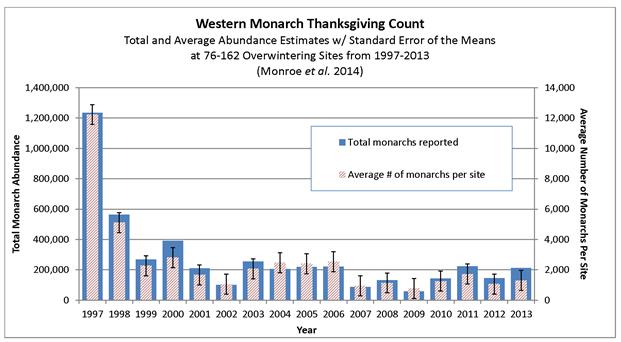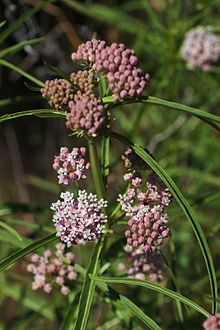In theory, California should count its blessings (sorta) when it comes to the number of monarch butterflies that have passed through the state this winter season. A new report from the Xeres Society reveals that the number of flappers that have overwintered in California has remained steady from previous years.
Data from the Thanksgiving count estimates about 2,000 butterflies at 162 counting sites, which is slightly up from last year, but nowhere near the peak numbers the state experienced in the 1990s.

Monroe, M., D. Frey, and S. Stevens. 2014. Western Monarch Thanksgiving Count Data from 1997–2013.
Elsewhere in the country, monarch numbers are scrapping the bottom and overwintering population in Mexico has shrunk to the lowest on record. Scientists have been charting this very scary trend in recent years. In 2012, just 60 million monarchs arrived at their Mexican habitats, and World Wildlife Foundation Mexico puts that number even lower to perhaps 33 million.
The causes for the decline are the typical litany: habitat destruction, massive drought in Texas, cold weather in the Southern states and changes in agricultural practices which remove nectar plants and the monarch’s chief food supply: milkweed. In short, many monarchs are dying from lack of fuel (food) along with the open habitat that used to provide their food.
The question: “Will the monarchs bounce back?” doesn’t seem fair. The more important one is “Will humans thoughtfully incorporate space, resources and food for monarchs into the landscape?”
Backyard gardens overflowing with milkweed is a start (here’s our list below on where to find plants in SoCal), but this dire situation requires bigger solutions from farmers, civic leaders and large agricultural organizations…not to mention a lot of noise from butterfly activists.

Grow Native Nursery, affiliated with the Rancho Santa Ana Botanic Garden, and with locations in Claremont and Westwood, sells Asclepias fascicularis, A. speciosa and often the desert A. subulata
Laspilitas Nursery, located in Escondido
Moosa Creek Nursery, in Valley Center, sells Asclepias fascicularis and A. speciosa
Recon Native Plants, in San Diego, sells A. californica and A. speciosa (wholesale only)
Tree of Life Nursery, in San Juan Capistrano, sells A. speciosa
*Note: Asclepias speciosa is not actually native to the southernmost ~1/3 of the state, but it’s a beautiful plant and many nurseries are offering it. Remember to always call ahead — or check their websites — before heading over to pick up your milkweed.
